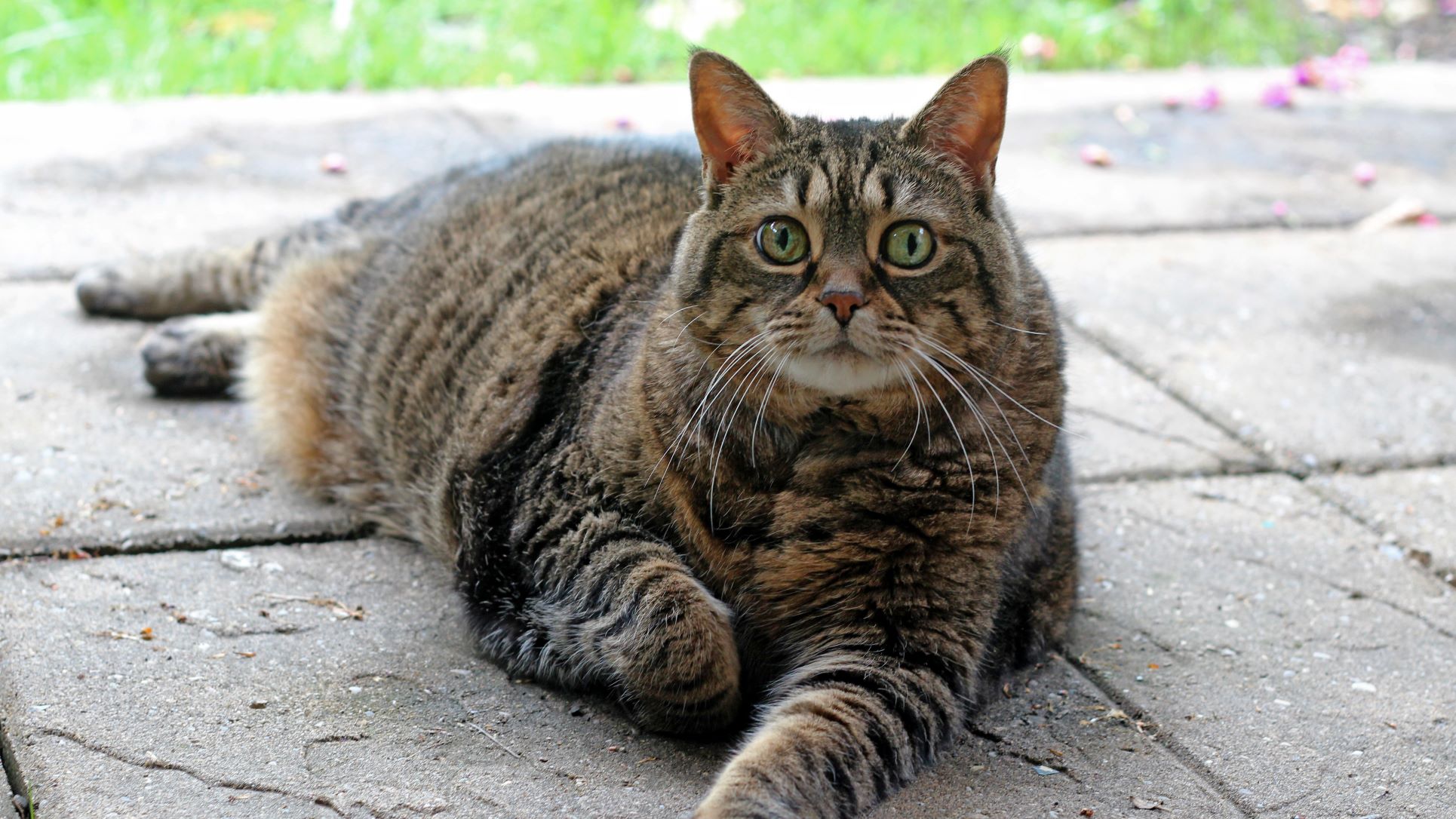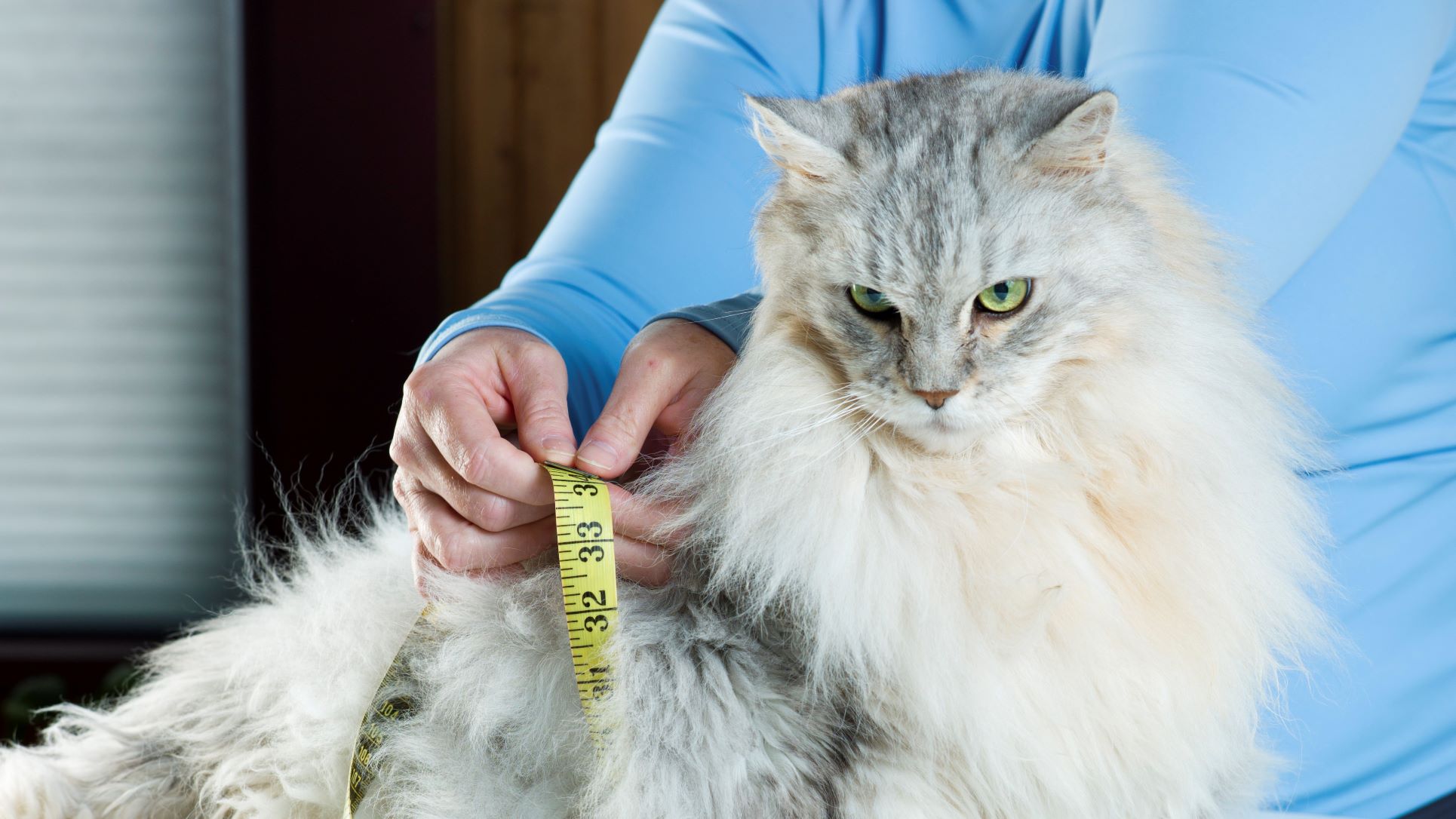Is my cat overweight?
Wondering ‘is my cat overweight’? Let our feline expert help you decide…

If you’re wondering is my cat overweight? And perhaps how to afford copious amounts of the best dry cat food to keep up with their appetite - you’re not alone. Many pet owners are concerned about their cat’s weight and for good reason; around 58% of cats are overweight, according to the AVMA.
From feeding our cats every meal to making sure our homes are filled with fun enrichment toys, we all want the best for our cats. But sometimes that means taking less fun measures, like putting your cat on a diet.
If you’re worried about your cat's weight, our feature will tell you how to accurately tell if they are overweight, what the risks associated with extra weight in felines are and what you can do to help your kitty shift any excess weight.
How can I tell if my cat is overweight?
First things first, how can you actually tell if a cat is overweight? Professionals typically take into account not just their weight, but their overall body condition. “We always refer owners to the ‘Body Condition Score’ (BCS) matrix as a guide to assess whether their cat is at a healthy weight. The BCS matrix takes into account a cat's size and shape, and provides an overall outline to help assess their weight,” says Steph Drake, Community Outreach Officer at Woodgreen Pets Charity. “However, it is important to note that cats come in different shapes and sizes, but maintaining a healthy weight is crucial to their overall health and well-being. It is recommended that cats be in the 4/5 categories,” she adds.
It can be tricky for owners, who see their cats every day, to tell if their cat is overweight or not. If you’re in any doubt about your cat's weight, take them to your veterinary clinic for a well-being check-up.

Steph Drake is a highly experienced animal welfare professional, with over 30 years spent working in cat rescue, and holds a Master's in Clinical Animal Behaviour. Her work has focused on helping feral cats and kittens through trap, neuter, and release (TNR) schemes and re-siting them to safer locations. Having owned her own pet-sitting business for almost two decades, Steph also has a deep understanding of animal care and handling. In October 2020, she joined Woodgreen Pets Charity, where she worked in the Cats section before moving to the Outreach team. In her current role, Steph educates and supports pet owners to ensure that their pets' welfare needs are met, making a positive impact on their lives.
What is considered overweight for an indoor cat?
Indoor cats typically get less exercise than cats that have access to the outdoors, so it’s understandable that you might be a bit more concerned about an indoor cat's weight. But is there a specific weight you should aim for? Unfortunately, it’s a bit more complicated than that.
“Cats vary considerably in terms of size and shape, and as such, there is no specific weight recommended for indoor cats. The Body Condition Score guidelines are a more accurate way to assess a cat's weight regardless of whether they are kept indoors or allowed outside,” advises Drake.
PetsRadar Newsletter
Get the best advice, tips and top tech for your beloved Pets
An indoor cat may have more trouble controlling their weight, especially if they’re allowed access to food to graze on all day. While there are no specific weight recommendations for indoor cats, how you treat a weight problem in an indoor cat might vary. For example, you might engage in a bit more deliberate indoor exercise and restrict feeding to set times.

What are the risks for overweight cats?
An overweight cat is no laughing matter, feline obesity comes with several health risks. “Overweight cats are at higher risk of developing serious health problems such as diabetes and a compromised immune system,” says Drake. Aside from actual diseases, there is the matter of their enjoyment. “Being overweight can have a significant impact on a cat's mobility and overall quality of life. The additional weight puts extra pressure on joints, causing pain and stiffness that can make it difficult for cats to move around, jump or climb,” says Steph.
Plus being overweight can start a negative cycle of behavior, which can in turn lead to further health complications. “Reduced activity levels can also lead to reduced water intake and increase the risk of urinary tract infections and stones. Grooming can also become problematic for overweight cats, as they may be unable to reach certain areas of their body for self-grooming, leading to matted and soiled fur, and potentially causing skin irritation and infections,” says Steph. Sadly, carrying extra weight can also reduce your pet’s life expectancy by more than two years, according to the AVMA.
What to do if your cat is overweight?
If you’ve checked out the Body Condition Score or spoken to your vet and are concerned about your cat's weight, try not to panic. There is plenty you can do to help your feline friend reach a healthy weight.
First up? Make sure you’re 100% sure on all the facts. “To help your cat lose weight, it's important to start with an accurate weight and advice from a veterinarian or animal charity on the amount of weight that needs to be lost initially, based on the Body Condition Score guidelines,” advised Drake.
Once you have those metrics in place, you can plan better. “Calculate the amount of food your cat should be having each day, based on the weight you're aiming for, and weigh out the daily allowance rather than guessing. If your cat eats wet food, remember to reduce the quantity of dry food,” says Steph.
And when it comes to losing weight, while diet might be king, exercise plays a supporting role so don’t overlook your cat's activity levels. “To encourage your cat to move more, try putting the food in treat balls, puzzle feeders, or scatter it rather than having it all in a bowl. Interactive toys (here you will find some of the best interactive toys on the market) such as fishing rod types can also help to encourage movement. Laser pens are not recommended as cat toys, as they can cause frustration,” says Drake.
If you’re a feeder and can’t resist dishing out the treats, you might need to rethink your actions. “It's also important to cut out any treats or snacks of human food, as these can add up to the calorie intake,” says Steph.
But what if your poor cat seems hungry on a reduced calorie diet? “Consider trying a satiety diet that will make your cat feel fuller for longer, or a light version of your regular food. Remember to switch foods gradually over about a week to avoid upsetting your cat's stomach,” says Steph.
By following these steps, you can make changes to your cat's diet and routine that will help promote a healthy weight and improve their overall quality of life.
You might also want to read our guide that answers, 'How much should I feed my cat?' and how to improve your cat's diet. Or, learn about obesity in cats.

Abby is a freelance writer and dog owner. She currently has two golden retrievers, Lowen and and Indy, but has previously had many other pets, including rabbits.
Abby has written for Metro, House Beautiful, Fit+Well, and more. Alongside this, Abby also volunteers at a local dog rescue centre, helping out with daily activities, such as walking, feeding and grooming.
